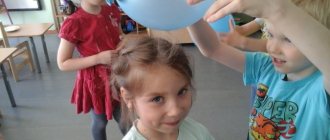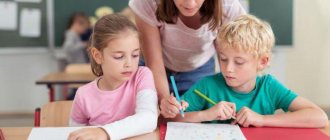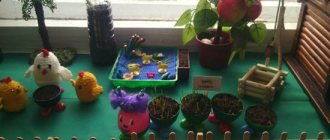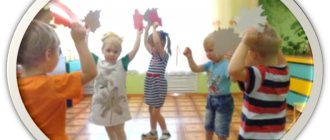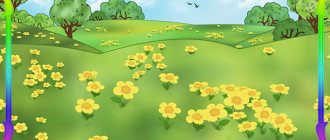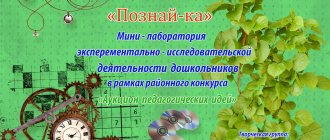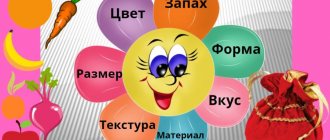Organization of educational and research activities
Cognitive and research activities in the younger group, according to the Federal State Educational Standard, should be aimed at improving and strengthening such important qualities in preschoolers as the desire to learn and conduct experiments.
Although the modern pedagogical system is not characterized by direct transfer of knowledge, this makes it possible to develop in children the necessary motivation to search for new knowledge using any methods.
Experiences and experiments are an effective method of teaching cognitive and research activities in the younger group
The organization of such activities is primarily aimed at encouraging curiosity, finding answers to any questions and increasing attentiveness as such . In this case, knowledge is manifested both in independent studies and during training with a teacher.
This ability to pose a clear question in relation to a little-studied object or subject and then find an answer determines the high level of development of the child’s intellect and psyche. Simply put, children are real researchers who need help finding a solution to a problem.
Goals and objectives
The fundamental goal for organizing this type of activity is the systematic development of a research type of thinking. This feature is not characterized by the erroneous opinion that in such a case the teacher is raising a research assistant or future researcher, because such knowledge will certainly be useful in any situation in adulthood.
Thanks to the process of observation or research, the child develops the ability to receive real and sincere delight from a new discovery, therefore it is not entirely correct to invest ready-made information into a preschooler. It is best to give him the opportunity to discover the world around him from a new side.
Using visual, sensory or auditory perception techniques, children learn to determine the basic properties or qualities of the objects and phenomena being discussed. This allows you to develop effective analytical thinking, thanks to which a person can establish a cause-and-effect relationship, regardless of the situation or mood.
The main goals of cognitive activity, through which the primary goal of preschool education is revealed:
- creating interest in phenomena or objects that are in the surrounding world;
- improving basic knowledge about the properties and features of an object: color, shape, size, depth, etc.;
- development of the child’s intellectual abilities, including comparison, classification, as well as the correct establishment of relationships between certain objects and self-orientation in space and time;
- improving the positive context that will be used to independently find the necessary knowledge or information;
- developing the ability to work with a variety of tools, which in turn improves fine motor skills of the hands;
- motivating the child to the process of observation and cognition.
Research activities make it possible to understand the properties of the environment as broadly and objectively as possible , including the structure of the world as such. Thanks to this, the child’s intellectual, psycho-emotional or physical qualities quickly develop.
Techniques used
Cognitive and research activities in the younger group are characterized by the presence of various methods and techniques that can significantly simplify the learning process.
The most popular and used in practice are:
- Heuristic method. In this case, the teacher creates a certain problem in order to motivate the child. Thus, it is possible to form a sense of group cohesion in the preschooler in order to find the answer to a particular problem and activate intellectual abilities to analyze the problem. Improving speech, research and inquisitive skills is facilitated by various conversations where the problem is discussed. The teacher must determine the question based on the child’s level of knowledge and also take into account the age of the group. At the same time, the teacher forms clarifying and leading questions in order to lead the preschooler in the right direction. Within the junior group, the duration of such a conversation is from 10 to 15 minutes.
- Observation. Such a process is most often organized within a certain room in a preschool educational institution or on the street, where the perception of various objects or phenomena comprehensively develops the child’s auditory and visual abilities. Those explorations that are carried out during a walk better immerse the preschooler in the world around him due to a greater number of images, smells, colors or sounds.
- Experiments and conducting experiments. Along with the game process, experiments are considered one of the main forms of activity of a preschooler. Thus, when carrying out basic research on objects in kindergarten, the child acquires an important understanding of how they work and begins to see the basic properties and features of objects. Preschoolers with great enthusiasm and pleasure conduct experiments with substances that they already know - clay, sand, plants. Such a research process best creates a desire to conduct independent experiments. This method especially develops concentration, observation, discipline, and also contributes to the development of a friendly atmosphere in the team.
- Project activities . This type of work is aimed at the research activity of preschoolers and teachers, and in some cases, parents. In this case, both the child’s thinking and creative skills are used. The teacher must properly motivate the student to make independent observations and experiments, helping the preschooler only when particularly necessary.
- Technologies using the TRIZ method . It consists of solving electoral tasks, thanks to which the child can independently build algorithms and action plans in order to solve this or that problem. Such a technological solution in kindergarten is often used in a playful way, which allows for more effective interaction with students. The teacher builds fairy-tale plots around learning, which gives the preschooler the opportunity to learn together with their favorite toys or characters from fairy tales and cartoons.
During experiential learning, the child learns the important analysis of information . In this way, a preschooler can learn a new skill by comparing its advantages and disadvantages, and also find more effective teaching methods.
Fabric, its qualities and properties
To teach to recognize things made of fabric, to determine its qualities (thickness, surface structure, degree of strength, softness) and properties (creases, cuts, tears, gets wet, burns). Samples of cotton fabric in two or three colors, scissors, alcohol lamp, matches, containers of water, algorithm for describing the properties of the material. Children play with dolls dressed in cotton dresses. The adult invites the children to think about what the dresses are made of; what color is the fabric; What else do they know about this material? Offers to determine the qualities and properties of fabric. Each child takes a piece of fabric of the color they like, feels it, reveals the surface structure and thickness. He crumples the fabric in his hands (crumples), pulls two opposite edges (stretches); cuts the piece into two parts with scissors (cuts); dips a piece of fabric into a container of water (gets wet); compares changes in fabric in water with wet paper (fabric retains its integrity better than paper). An adult demonstrates how fabric burns and tears under strong tension. Together with the children, he creates an algorithm for describing the properties of the material.
Types and forms
In order to implement and implement previously set tasks, the teacher introduces certain classes within the framework of available types of interaction: a comprehensive study of the features of the surrounding world, understanding of basic mathematical elements, preparatory training in various skills.
Thus, the study of vowel sounds can begin with the introduction of auditory analysis. The teacher asks the children: “What sound begins the word YAMA?”, after which he invites the preschoolers to count and pronounce all the sounds they hear. Then another word is taken, within which the same task is carried out.
Cognitive and research activities in the junior group are carried out based on the following forms:
- Group or collective. In this case, classes aimed at improving the research impulse are conducted in a group in the presence of the following principles: structure, accessibility and short duration. Thus, each child should take part in direct study in the study, while it is necessary to avoid unnecessary fatigue and, if possible, use physical and playful interaction.
- Subgroup. In this case, the research process is formed in relation to the created subgroups - when the results of the experiments are counted after a comparative analysis of all teams.
- Individual . Here the teacher introduces cognitive tasks as part of individual learning. If the general level of intelligence, skills or knowledge lags behind the average value in the group, the teacher should in every possible way contribute to the motivational component of the student.
Preschoolers also gain new knowledge during a walk, during which they observe various objects and phenomena in inanimate and animate nature . Such observational classes in the younger group are short-term in nature, where the main goal is to obtain new information about the world around them.
Main types of educational and research activities:
- Research and search. It is characterized by the presence of joint work between children and the teacher, due to which the problematic issue is resolved much faster. Most often used as part of a heuristic conversation on the topics “Why do people wash their hands after going outside?”, “Why doesn’t a wooden block sink in water?” and others.
- Informative. It is distinguished by the independent activity of students who, during the cognitive process, quickly assimilate and use previously acquired knowledge in practice. This approach is most often implemented using the methodological rules of TRIZ, as well as using didactic games to develop analytical and spatial thinking.
- Cognitive and practical. In this case, the teacher spontaneously or in an organized manner develops the independent activity of each child, where the main emphasis is on gaining knowledge in practice. The view can be realized both in the case of experiments and with the help of observations and experiments.
- Research-subject . Independent or group activity of a child in order to more accurately and effectively establish a cause-and-effect relationship between objects or phenomena in the surrounding world. This allows you to better expand your knowledge about the basic properties or features of the subject under discussion. It is best realized through the study of a variety of materials: wood, plastic, paper or fabric, as well as living beings or flora in the process of their development.
Due to the presence of various forms and types, the teacher can find a common language with literally every student. It should be remembered that training is most effective and fast when using all the above-described varieties at the same time.
Project on experimental research activities in the junior group “I Observe and Learn”
Project
in experimental research
activities
“I observe and learn
2021
Relevance of the project:
In preschool age, experimentation is the leading activity, and in the first three years it is practically the only way to understand the world. It is known that familiarization with any subject or phenomenon gives the most optimal result if it is effective. It is necessary to provide children with the opportunity to “act” with the objects they are studying in the surrounding world. Children love to experiment. This is explained by the fact that they are characterized by visual-effective and visual-figurative thinking. The main method of experimentation for children of primary preschool age, I chose to conduct elementary games - experiments.
Target:
Creating conditions for the formation of the foundations of a holistic worldview, through play through experimental activities.
Tasks:
1. Create conditions for children’s experimentation in the group room.
2. Expand children's understanding of the world around them.
3. Develop skills in conducting basic experiments with paper, sand, water, air (together with the teacher)
4. Develop thinking and speech in the process of cognitive and research activities.
5. Develop children’s cognitive activity in the process of experimentation.
Project type:
educational - playful.
Implementation period:
long-term 09/02/19 – 05/31/20
Project participants:
Children, teachers, parents.
Stages:
1. Preparatory.
Drawing up a project passport, preparing material for experimental activities, selecting games, riddles, poems.
2. Basic.
Planning educational activities, working with parents.
3. Final.
Create a corner for children in the group to independently experiment with natural and waste materials.
Long-term project planning
| date | subject | target | tasks | content |
| 04.09 | "Bubble". Consideration | Introducing children to soap bubbles. | Help raise the emotional mood of children. | Show the kids how to play with bubbles (catch them with your palms, jumping up, blow on them to make them fly away, watch) |
| 11.09 | "Ripples on the water." Experimentation | Development of the respiratory apparatus. | Encourage children to become interested in what is happening. | Place a bowl of water on the table. Draw children's attention to the fact that when you blow on some water, ripples appear on the surface. |
| 18.09 | "Bottles with a surprise." Experiment | Differences in auditory attention. | Encourage children to become interested in what is happening. | We take bottles with a surprise out of the box and show the children how to turn them over and shake them to make sounds. We tell you how it sounds - loud - quiet. |
| 25.09 | "Water cold and hot". Experiment | Teaching children to determine the temperature of substances and objects. | Develop tactile sensations. | Fill the bottles with hot and cold water. Let it touch and compare the temperature by touch. Talk about where the water is (cold, hot) |
| 02.10 | "Wonderful bag" (No. 1 in form) Experiment | Teaching children to identify an object by its shape by touch (ball, cube, brick). | Teach children to determine the shape of an object by touch (ball, cube, brick). | Teacher: “What do I have? Wonderful bag." Children take out balls, cubes, bricks from it, pronouncing the names of the figures together with the teacher. |
| 09.10 | "Air under water." Experiment | Observing what happens in the water when we blow into a straw. | Develop the breathing apparatus. | Insert a straw into a bottle (glass) with boiled water and blow into it. Bubbles appear. Encourage children to blow into their tubes too. |
| 23.10 | "Light heavy". Experience | Introducing children to the weight of objects. | Show that objects can be light and heavy. Learn to determine the weight of objects and group them by weight. | Two handbags. In one there is a balloon or pine cones (light bag), and in the other there are pebbles (heavy bag) |
| 06.11 | "Games with a sponge." Experiment | Creating conditions necessary for children's sensory development. | Introduce the properties of a sponge. Learn to pick up water with a sponge and squeeze it into a container. Cultivate interest in experimental activities. | The teacher deliberately spills water into the tray where the sponges lie, and then asks the children to help, remove it with the help of “helper sponges.” Having previously shown how this can be done. |
| 13.11 | "Balloons with a surprise." Consideration | Development of fine motor skills of the hands. | Develop tactile sensations. Arouse children's interest in the fact that different balloons have different fillings. | A dog came to visit with a box, and what is in it, I wonder? We take out balls filled with cereals (buckwheat, rice, millet, peas) and starch. We study them, touch them. |
| 20.11 | "Clothespins." Experimentation | Development of fine motor skills of the hands. | Develop fine motor skills of the hands. Teach children to press the edges of the clothespin to open it. | Draw the children's attention to the stretched ropes on which multi-colored clothespins hang. Show the children how to use clothespins. Encourage them to repeat these actions. |
| 27.11 | "Paper". Experiment | Introducing children to the properties of paper. | Introduce children to the properties of paper: it is light (can be blown away from the palm of your hand, crumples, tears, rustles, does not sink in water. Arouse interest in various manipulations with paper. | Start rustling with candy wrappers (paper, attracting children with an interesting sound. Let them try to crumple it themselves. Next, show different types of paper (napkin, candy wrapper, for drawing, etc.) and demonstrate what can be done with each of its types. |
| 04.12 | "Wonderful bag" №2 (by color). Experiment | Teaching children to match objects by color. | Develop tactile sensations. Give children the names of flowers and activate their speech. Create a positive emotional mood in children. | The teacher takes a figure (cube, ball, brick, triangle) of a certain color from the bag and asks the child to find the same one in the group. |
| 11.12 | "Game with a feather." Experimentation | Creating a positive emotional mood in children. | Form a vocabulary: parts of the body. Encourage children to pronounce words together with the teacher. | Take a colored feather and act according to the words: Look, look what I brought! It quietly crawls along the palm, First in a circle, then forward. It extends along the handle to the shoulder. And it very gently caresses the neck, crawls down the other hand, again quietly creeps along the palm, first in a circle, and then in flight. Where will it fly? Interest Ask. A feather landed on a small nose! Then the feather wants to stroke these ears. One and the other tickles a little. But now the feather needs to rest, It flies into your pocket to lie down. |
| 18.12 | "Games with sultans." Experiment | Developing in children the ability to exhale air through the mouth, activating the muscles of the lips. | To develop in children the ability to exhale air through the mouth. Introduce children to one of the properties of air - movement (wind). Creating a positive emotional mood. | Teacher: “What’s in my basket?” We get the sultanas. We blow (like the wind blows) - they move. If we don’t blow (no wind), they don’t move. |
| 25.12 | "Wonderful bag" №3 (feels like) Experiment | Development of tactile sensations. | Develop tactile sensations. Form a vocabulary: prickly, smooth, soft, hard. Create a positive emotional mood in children. | Teacher: “What do I have? Wonderful bag." Children take massage balls out of it (spiky balls, smooth balls, a fabric cube (soft, a plastic cube (hard).) Talking about each object what it is. |
| 15.01 | “Let’s hang up the handkerchiefs.” Experimentation | Development of fine motor skills of the hands. | Develop fine motor skills of the hands. Teach children to attach scarves to a string using clothespins. | Draw the children's attention to the washed handkerchiefs for the doll, which need to be dried. Show the children how to use clothespins to hang laundry. Encourage them to repeat these actions. |
| 29.01 | "Find by sound." Experiment | Fixing the names of musical instruments. | Identify and distinguish noise sounds made. Creating a positive emotional mood. Fix the names of musical instruments. | Toys came to visit us: a bear with a tambourine, a bunny with a rattle, a cat with a bell, etc. We hide it behind a screen and guess what it sounds like. |
| 05.02 | "Snow. What is he like? " Consideration | Introduction to the properties of snow. | Introduce the properties of snow in frosty weather (fluffy, cold, white, moldable, melts in your hands). Develop tactile sensations | Collect snow in a bowl and bring it to the group. Children get acquainted with its properties by touching it. |
| 19.02 | “What's in the package? " Experiment | Teaching children how to show. | Teach children to perform actions as shown by the teacher. Create a feeling of joy and interest. | We fill the plastic bag with air and close it. When we open the bag, the air comes out and the bag is empty. |
| 26.02 | “Open, close.” Experience | Development of fine motor skills of the hands. | Develop fine motor skills of children's hands. Encourage interest in what is in the jars. Increase emotional mood. | She brought jars with something inside (pine cones, toys, etc.). The boys and I are learning to open these containers and see what’s in there. |
| 03.03 | “Find the same bottle by sound.” Experience | Development of children's auditory attention. | Teach children to compare sounds and find similar ones. Cause joy and surprise in children. | Show the children a box with bottles (two each with the same fillings, filled with beans (peas, millet) (semolina, water. And, demonstrating how each of the bottles makes noise, offer to find the same one by sound. |
| 17.03 | "Let's play with the sun bunny" Consideration | Developing an understanding of the causes of sunbeams | Introduce the origin of sunbeams, their movement, the objects from which they are reflected. Develop ingenuity and curiosity. Teach children to act in accordance with the text, at the teacher’s signal; run in all directions without bumping into each other. Learn to let in sunbeams (reflect light with a mirror). Create a feeling of joy and surprise. | We looked out the window - the sun was shining. Educator: “What do I have in my hands? Mirror. Let's look for the bunny. Where is the bunny? Here he is. Who gave it? Sun. Let's play with him: Sunny bunnies are playing on the wall, lure them with your finger, they will come running to you. After a pause, he gives the signal: “Catch bunnies!” Children run to the wall and try to catch the bunny slipping from under their hands. |
| 01.04 | "The wind blows across the sea." Experience | Strengthening the ability to exhale air through the mouth, activating the lip muscles. | Continue to introduce children to such a natural phenomenon as wind. Learn to distinguish and regulate its strength yourself. Raising emotional mood in children. | There are paper boats in a basin of water. Children blow on the boats strongly - the boat floats, they blow quietly - it stands still. |
| 14.04 | "We play with sand." Experimentation | Development of fine motor skills of the hands. | Raise the emotional mood of children. Teach children to pour sand into different containers. | Show the children how to pour sand with a spoon into a funnel inserted into a bottle, and then from the bottle back into the box. Encourage them to do so themselves. |
| 28.04 | "Floats, sinks." Experience | Consolidating knowledge about the weight of an object. | Learn to identify light and heavy objects (some remain on the surface of the water, others sink). Help create a joyful mood. | We put stones in a basin of water - they sink, and plastic balls - they float. |
| 13.05 | “What’s in the tube? » Experiment | Developing curiosity in children. | Teach children to use a stick to push small objects out of a hollow tube (untie a bag with a toy, open a box). Develop perseverance and patience. Create a feeling of joy and surprise. Develop fine motor skills of the hands. | Place a toy wrapped in bright fabric or a box with a lid inside the tube. Show the tube to the baby and ask: “I wonder what’s in there?” If he doesn’t figure it out on his own, use a stick and show how you can use it to push out the package. Unfold it and show the toy, naming it. Let the child try to untie the bag himself. |
| 20.05 | "Samodelkin's board." Experiment | Development of fine motor skills of the hands. | Develop fine motor skills of the hands. Raise the emotional mood of children. | Draw the children's attention to a board with interesting devices, show how they can be manipulated. |
Literature
1. Dybina O. V. “Child in the world of search”; 2. Dybina O. V., Rakhmanova N. P., Shchetinina V. V. “The unknown is nearby” (entertaining experiences and experiments for preschoolers); 3. Zubkova N. M. “A cart and a little cart of miracles” (experiments and experiments for children, “scientific answers to children’s “whys.” 4. Ivanova A. I. “Methodology for organizing environmental observations and experiments in kindergarten.” 5 Ryzhova N.A. “Our home is nature” 6. A.I. Savenkova “Methods of conducting educational research in kindergarten” 7. Shapiro A. I. “Secrets of familiar objects”;
Stages of research activity
Cognitive and research activities in the younger group are characterized by the presence of stages of education that make it possible to most effectively solve a particular issue within the framework of experiments.
In pedagogical practice, there are the following stages of a child’s scientific activity:
| Stage | An example of a stage based on the experiment “How can plants drink water?” |
| Statement of a problematic question | Children determine exactly how plants can consume liquid. |
| Identifying the main purpose of the experiment | Pupils develop various options for solving the problem, which contributes to the desire to conduct observational activities at the plant and understand how it drinks water. |
| Putting forward a theory | The child thinks about how he can see the process of drinking liquid without resorting to special equipment. To do this, preschoolers use colored liquid to more effectively track the consumption process. |
| Testing the theory | In this case, each student dilutes a common food dye in a small vessel with water. After this, the child puts a cabbage leaf or a white clove into the prepared liquid. |
| Analysis and monitoring of results | Arriving at kindergarten in the morning, preschoolers discover that the leaves of cabbage or cloves have been saturated with the same shades that the children added to the water. |
| Formulation of the resulting conclusion | Students see that the water gradually rises to the top of the flower, causing any plant to consume water only if the roots and bottom are properly planted. Thus, the child discovers the process of “drinking water” with the help of the root system. |
Such experimental activities in the younger group allow the child to understand the basic properties of a particular process that occurs in living or inanimate nature. Research makes it possible to gain certain knowledge or skills without their direct assignment, due to which the preschooler is more interested in the observation process.
Taking into account the variability of the stages described above, the teacher can modify them in accordance with the specific characteristics of each child. Thus, a preschooler is able to explore the interaction of the environment using the observation method, depending on age, cognitive abilities and other important characteristics.
The variety of stages of interaction with schoolchildren makes it possible to implement pedagogical plans much faster, while the teacher can quickly monitor any changes in the educational process, as well as display the final result of a particular technique.
HUMAN
Cheerful men playing
Introduce the structure of the human body: torso, legs, arms, feet, fingers, neck, head, ears; face – nose, eyes, eyebrows, mouth; hair. A set of toys (a naked doll, a fish, any animal, a bird), a “wonderful bag”, a mirror, dummies of human body parts (torso, legs, arms, feet, neck, head). An adult invites the children to play the game “Wonderful Bag”: find a little man (naked doll) in the bag by touch. Children take turns completing the task and explain to the adult how each of them found out that this is a man (he has a torso, two arms, a head, etc.), and why he didn’t choose another toy (it has a tail, wings and etc.), for emotional living and to intensify the examination of the body, you can play the musical game “Where, where are ours...” (name of body parts) and “Measurements”, when children measure themselves and find out who has longer or shorter legs and arms , who is taller). You can also offer the game “Show (do) what I say” (jump on one leg, show your ear, etc.).
Motivating start to classes
Cognitive and research skills are developed from childhood, which is characterized by an increasing desire for the process of observation, including direct interaction with the object or phenomenon being studied. Such activities in the younger group are aimed at obtaining basic knowledge about a particular subject.
Preschoolers are particularly drawn to small laboratory activities where a variety of tools can be used to support exploration.
The teacher needs to interest the child by organizing research activities so that the preschooler is highly motivated to acquire new knowledge.
Considering the fact that often the practical or preparatory side of experiments causes much more positive experiences in the child, he is able to lose the desire to obtain a final answer to the question asked.
In this case, various pedagogical techniques are used, including visual posters, maps, as well as didactic and outdoor games.
The teacher can also introduce a surprise factor, which significantly increases the child’s involvement. In this case, you can resort to some pleasant surprise, due to which the preschooler will be motivated even more. It is important to create the most comfortable and favorable environment for learning.
To ensure that motivation is not lost, meetings should be held with parents , at which the main points of development need to be explained. This way, children can carry out their exploration activities at home, which greatly increases their engagement while improving the quality of the learning itself.
Clay, its qualities and properties
Teach to recognize things made of clay, determine its qualities (softness, plasticity, degree of strength) and properties (crumples, breaks, gets wet). Clay objects, pieces of clay, water, work stands, containers, an algorithm for describing the properties of the material. An adult organizes an exhibition of clay toys. After examining it with children, he finds out what all the toys are made of; what material was used; What else would children like to know about him? Then he offers them stands with pieces of clay lying on them and asks what can be molded from them and why. Children roll a ball (the clay is soft, plastic, it can be crushed: make a cake from the ball, etc.). Place a small piece of clay in a container of water and watch it soak. An adult demonstrates how a clay toy breaks easily. Together with the children, he creates an algorithm for describing the properties of the material.
The use of visual material when organizing experimental activities in preschool educational institutions
Within the chosen topic, the teacher must provide the child with any tools that can simplify the memorization of information. This practice is especially typical for children of the younger group, since they have the best developed visual and auditory memory.
Also, research work must necessarily be characterized by a process such as documenting and recording the data obtained, including the result itself and the solution to the question. Children record their own observations, focus on conclusions, which helps develop analytical thinking.
To make it much easier for a preschooler to record information, the teacher resorts to the following note-taking methods:
- Observation cards . In this case, students fill out specialized forms, which subsequently complement the general file of research and experiments.
- Diary. This approach has great scope for realizing the child’s creativity, as well as expressing his individuality. The teacher can offer the preschooler both to write down the material and to make various diagrams, sketches or notes.
- Stand. In order to record the experiment, you can resort to the use of a common stand on which the general lesson plan is placed, including various photographs and diagrams with conclusions.
- Lapbook . In this case, the child independently develops a fold-out book, in which any information related to the experiment already conducted, based on its topic, is entered. It is best if the registration is drawn up together with the parents, which not only provides additional help, but also brings the child closer to the adult.
The result of any set of studies is the assessment of the preschooler’s results and monitoring of his activity throughout the entire observation process.
In this case, the teacher fills out a special table, which includes the following assessment criteria:
- correct formulation of the question;
- the number of hypotheses put forward by a preschooler;
- determination of the research method;
- recording the various nuances of observation using any available method;
- the child’s level of independence;
- the ability to draw conclusions, draw conclusions, and correctly draw general conclusions.
In the process of cognitive and research activities, the main need of preschoolers of the younger group for curiosity is satisfied. This pedagogical method allows not only to gain new knowledge, but also to arouse in the child additional delight and joy from the observed object or phenomenon.

